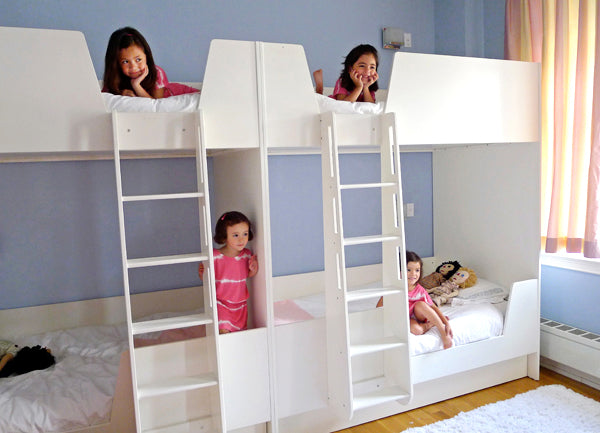Your Cart is Empty

We know that there are a ton of options out there for kid’s bunk beds, but we welcome the competition! We feel 100% confident that there are many distinguishing factors that make our company and our pieces the best choice out there. Let’s walk through a few reasons why you can feel confident about choosing Casa Kids.
Our bunk beds are made out of plywood for very specific reasons. Plywood was the perfect choice when it came to choosing a material that would make our bunks both durable and safe. Because these beds will be used by kids, each one needs to be able to withstand the years of wear and tear and climbing and sleeping and make-believe and games that your children will be exposing it to.
A lot of other bunk beds are made from cheaper woods such as pine or rubberwood, which is why they wear down quickly and often can’t withstand being disassembled and reassembled for a move. Even metal beds, which are more durable than the woods we mentioned before, can sometimes be shaky and unstable.
Another reason we chose plywood is that it allows us to avoid edgebanding, which is the method of lining the edges of furniture with a thin veneer or tape. Many other furniture manufacturers use edge tape to hide unsightly edges that appear when using cheaper materials. This tape creates sharper edges that are far from ideal for kid’s furniture. On top of that, edge tape tends to wear out quickly. Eliminating the use of edgebanding makes our beds safer and longer-lasting.
Our plywood iscertified by both the FSC (Forest Steward Council) and CARB (California Air Resources Board). This assures that the trees were legally harvested and that the bonding glue has no formaldehyde in it.
You might have noticed that our beds have exposed hardware, as opposed to many others that have hidden screws. This was intentional, and not just for aesthetic purposes. When researching other bunk beds, we found that many designs sacrificed sturdiness in order to conceal screws and other hardware. We completely disagree with this idea, especially when it comes to kid’s furniture. Safety is absolutely our number one priority, which made leaving the screws exposed the easy choice.
Although the choice was clear, we did notice a second perk to this decision. Leaving the hardware visible allowed for much easier and intuitive and assembly. This is always something we keep at top of mind when we design our pieces, which is why we also use only one type of screw. You won’t be sorting through a variety of little screws trying to figure out which one goes where when you’re assembling any of our products.
When we started to design bunk beds, we did a lot of testing and trying things out. Something we wanted to be sure of is that we were designing beds that would make sense to a child, and be easy for them to use without putting them in any danger.
We noticed that kids tend to prefer a handle to grip on thesideof a ladder or stairs, rather than using the next bar to pull themselves up. Hence, our side handle ladders:
We also noticed that when kids climb down from most bunk beds, the top step or rung was so close to the mattress that they would have to suspend themselves high above the bed, and strain to bend down to reach the next step. To prevent this, we make sure that our top step is at least 16 inches from the mattress so that they can easily climb down (which tends to be the part kids struggle with more).
The last thing we incorporated into our bunks to make them more kid-friendly actually ended up making them more parent-friendly too. We decided to give the option of stairs instead of a ladder. Stairs offer a few different benefits. Number one, as always, is safety. Simply put, stairs are safer than ladders. Secondly, box-shaped stairs provide the perfect opportunity for extra storage. Lastly, stairs are much easier for adults to scale. Tiny step ladders might be easy for small little kid feet to climb up, but they can be challenging for the rest of us. We always had a dream of designing a bed that a parent can climb up into with their kid for storytime (which is also the reason we made sure our bed had the weight capacity to handle both, our beds can accommodate a total of 600 lbs or less).
Are we the only ones who have noticed how unappealing the underside of most bunk beds look? If you’ve ever slept in a bottom bunk, you must know what we mean. The vast majority of bunk beds “support” mattresses with the use of slats, which are exposed from the underside of the bed. While this might be fine for a regular bed that sits close to the ground, a bunk bed implies that one of the two users will be staring up at the unattractive slats of the top bunk every time they’re in bed. Because of the spacing of the slats, blankets, sheets and mattresses often spill through. Overall, it’s just not a good look. We decided to design our beds with a full mattress support panel, like the examples pictured below:
These panels not only look better, but provide much more support for the mattress, which can help it last longer, and support your child’s back more consistently.